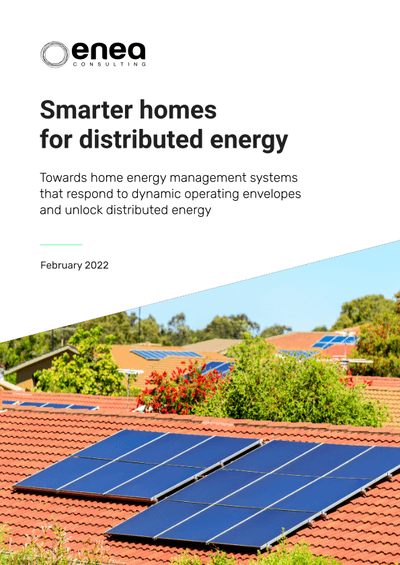Smarter homes for distributed energy

The Smarter homes for distributed energy study was prepared by Blunomy (Enea Consulting) for the Australian Renewable Energy Agency (ARENA), in support of the Distributed Energy Integration Program (DEIP) Dynamic Operating Envelopes Workstream. The study fits within a body_md of work addressing the complexity of implementing dynamic operating envelopes (DOEs) and looks at the readiness of home energy management systems to respond to DOEs.
The rise of DER
In Australia, the use of distributed energy resources (DER) such as rooftop solar, battery storage, and electric vehicles (EVs) is growing. As the uptake of DER continues to rise, the opportunities and challenges associated with integrating these resources into the electricity system is changing how local networks are operated.
Dynamic operating envelopes to support DER integration
A variety of future grid solutions are being deployed to optimise growing DER penetration, including dynamic operating envelopes. Operating envelopes are the limits placed on the electricity a customer can import or export to the electricity grid. In Australia, these limits tend to be static, or fixed. Dynamic operating envelopes, on the other hand, allow import and export limits to vary over time and location. Implementing DOEs could raise the need for a single home energy management system – or a HEMS – with the capability to coordinate (or orchestrate) DER and other on-site assets, such as hot water systems and air conditioners.
The study was made possible by insights gathered through consultation with 27 organisations across six industry stakeholder groups, as well as a research and analysis process. The study had four key objectives:
- Provide an overview of the current state of asset orchestration in Australia, and whether customer assets can be coordinated to comply with DOEs at the connection point
- Outline the benefits of orchestrating customer assets and asses the readiness of the HEMS market in Australia to orchestrate customer assets to meet DOEs at the connection point
- Identify gaps and barriers in terms of capability, market dynamics and standards and regulations Highlight possible areas for future investigation to progress DOE readiness.
HEMS in the context of DOEs
Today, HEMS are typically set up to focus on maximising self-consumption and reducing energy bills. Receiving and responding to DOEs represents an additional capability of a HEMS. A major finding of this study was that the HEMS providers consulted do not view receiving and responding to DOEs as a technical challenge.
For dynamic operating envelopes published at the connection point, the total power flows for the customer’s site will be required to remain within the published limits. In the near term, it is expected a single device – such as a solar PV system managed through a single smart solar inverter – will receive and respond to DOEs published at the connection point. As smarter home ecosystems become more developed, the coordination of multiple devices through a HEMS is expected to increase.
The stakeholders consulted in the study identified several gaps and challenges that are impacting HEMS deployment. In some cases, these gaps and challenges are creating uncertainty around how the HEMS market might interact with DOEs. As such, the study also outlines five potential areas for future investigation. Undertaking work in these areas could support the continued development of the HEMS market in Australia and facilitate the readiness of DOEs.